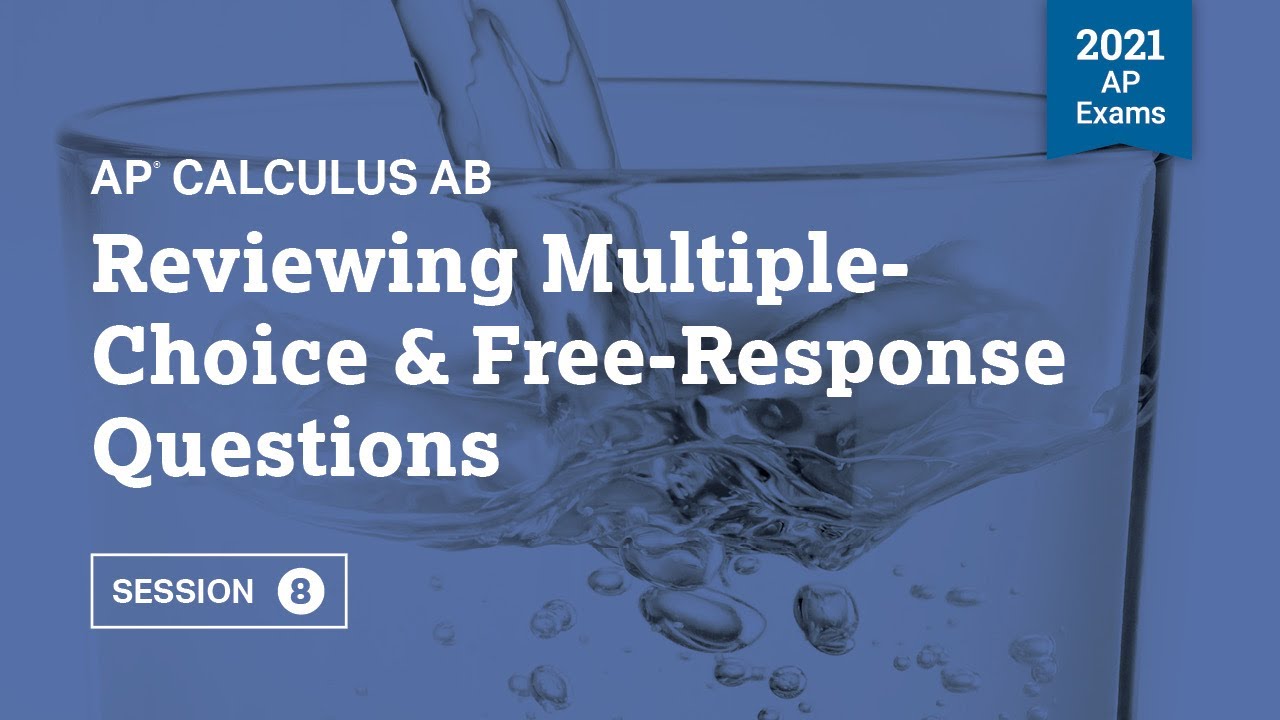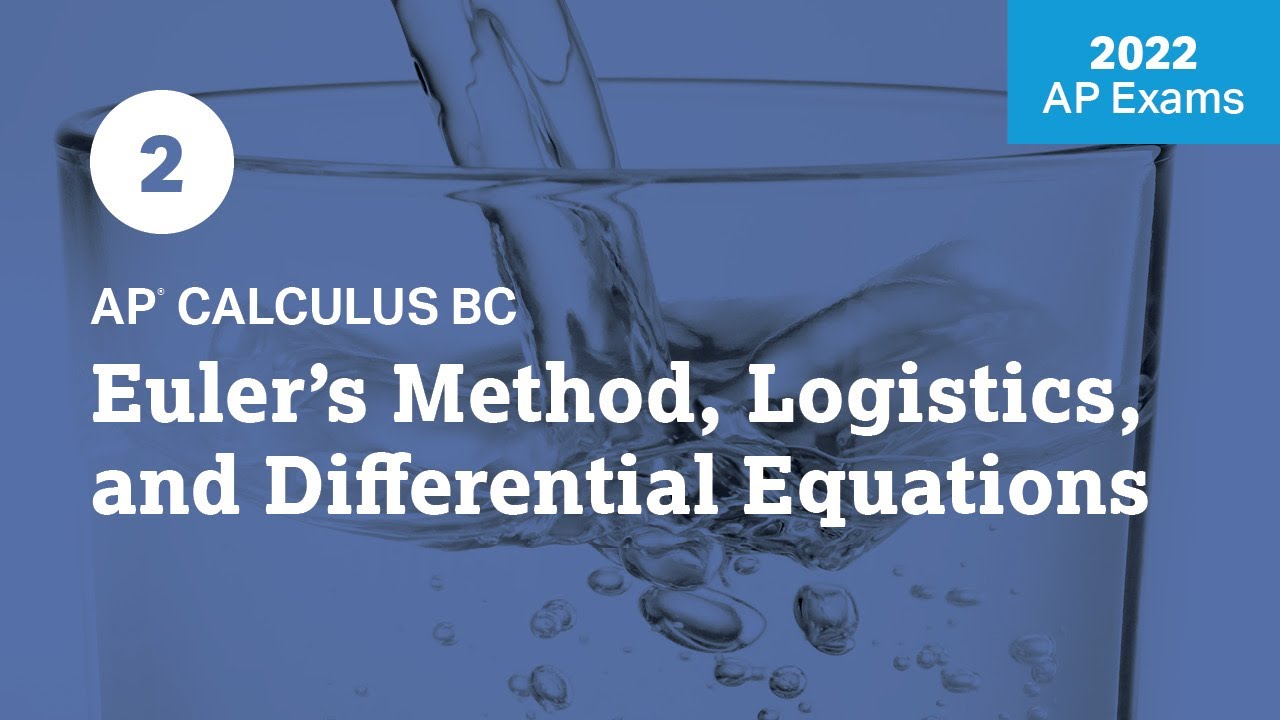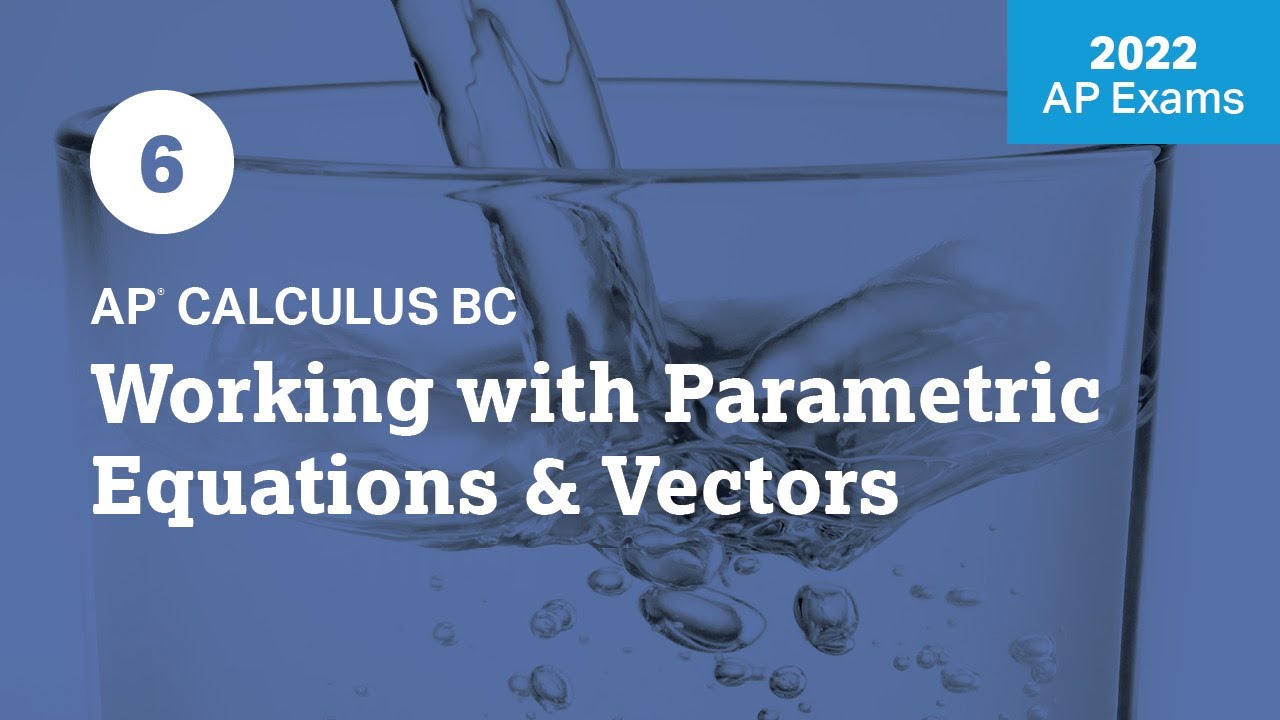Zoom session Last Minute AP Calculus Exam Review (May 11, 2020)
TLDRThis video script is a comprehensive review session for an upcoming AP exam, focusing on calculus concepts. The instructor covers exam preparation, including the use of demo exams, summary sheets, and reference materials. They discuss problem-solving strategies for topics like derivative graphs, Riemann sums, and differential equations, emphasizing the importance of understanding the exam process and potential issues with submission. The session also includes tips for handling the exam, such as using the correct paper and ink, and advice for dealing with technical disruptions during the test.
Takeaways
- 📚 The instructor emphasizes the importance of reviewing exam demos to ensure familiarity with the process, whether using a phone, tablet, or laptop.
- ⚠️ Students are reminded to have their e-tickets ready and to check their My AP account for any issues accessing them.
- 📝 It is recommended to print out resources such as the fall and spring summary sheet, derivative integral rules, and exam day tips for easy reference during the review session.
- 🔍 The instructor suggests reviewing FRQ assignments and mock exams, particularly derivative graph Remis on function table and differential equations, as they are likely to be the main topics on the exam.
- ❗ There is a reminder about the importance of having devices charged and having all necessary resources printed or downloaded to avoid any disruptions during the exam.
- 🚫 The session includes a warning against using internet searches or communication with others during the exam, as this could lead to disqualification.
- 📈 The instructor discusses how to handle the submission of exam responses, including the importance of stopping work five minutes before the end to prepare submissions and the potential issues with the AP physics test submissions.
- 🔗 A link will be provided after the session for those who wish to review the material covered, ensuring that students have access to the session recording for further study.
- 📅 The instructor plans to finalize grades in Infinite Campus after the exam and advises students to check their grades there, aiming to complete this by Wednesday but allowing until Friday.
- 📑 Students are reminded to use blank printer paper for any printed materials and to use black ink for the best visibility of their work by graders.
- 🤔 The session includes a discussion on the potential for a makeup exam if there are issues with the initial exam attempt, including the process for requesting one and the timeline for approval.
Q & A
What is the main purpose of the video script?
-The main purpose of the video script is to review key topics and provide last-minute guidance for students preparing for an AP exam, particularly focusing on math-related problems and exam strategies.
What should students have done in preparation for the exam as per the instructor's suggestion?
-Students should have gone through their exam demo at least once or twice to be comfortable with the process, printed out essential resources like summary sheets and reference sheets, and reviewed tips and advice from a previous video.
What are the 'big four' topics mentioned in the script that the instructor plans to cover?
-The 'big four' topics mentioned are derivative graph, Riemann sum, function table, and differential equations.
What is the importance of the fall and spring summary sheet, derivative integral rules, and the exam day catch sheet according to the instructor?
-These resources are important for students to print out as they provide essential information and formulas that will help them during the exam, ensuring they have all necessary resources at hand.
What advice does the instructor give regarding the use of devices during the exam?
-The instructor advises that students should ensure their devices are charged, use blank printer paper for writing, and avoid using lined or graph paper to make the work easier for graders to read. Also, they should use black ink for clarity.
What should students do if they experience issues with submitting their exam responses?
-If students face issues with submission, they should request a makeup exam using the provided link and explain the situation. If they are unsure whether their exam was submitted, they should also fill out the makeup request form to be safe.
How does the instructor suggest students handle the exam papers during the test?
-The instructor suggests that students have ten sheets of paper with their AP ID, initials, and numbers from one to five. They should use the sheets sequentially for each problem, ensuring that the work for each problem is clearly organized and numbered.
What is the instructor's plan for entering grades after the AP exam?
-The instructor plans to enter all student grades into Infinite Campus after the exam, aiming to complete the task by Wednesday but giving themselves until Friday, which is the deadline for grades.
What is the significance of the 'etickets' mentioned in the script?
-Etickets are important as they are required for students to log in and take the AP exam. Students should ensure they have their etickets and that they are able to find or see them in their My AP account or via an email from the College Board.
How should students approach the problem-solving during the exam, especially towards the end of the allotted time?
-Students should work on the problems diligently and stop what they are doing when there are 5 minutes remaining to prepare their responses for submission. They should avoid trying to squeeze in any last-minute work after the time limit to prevent risking the submission of their work.
Outlines
📝 Final AP Exam Preparation Tips
The speaker emphasizes the importance of final preparations for the upcoming AP exam, encouraging students to review their demo exams and familiarize themselves with the exam process across various devices. They highlight the necessity of having the fall and spring summary sheets, derivative and integral rules, and other resources printed or readily available. The speaker also stresses the importance of reviewing FRQ assignments and mock exams, particularly those covering derivative graph Remis on function tables and differential equations, as these topics are likely to appear on the exam. Additionally, they provide guidance on exam day logistics, such as having e-tickets, PID initials, and numbered paper sheets ready, and remind students to charge their devices and avoid internet searches during the exam to prevent any potential issues.
🔍 Detailed Exam Instructions and Post-Exam Expectations
This paragraph delves into the specifics of the AP exam procedure, including the use of e-tickets, the submission process, and the importance of using black ink and blank printer paper for clarity. The speaker also discusses post-exam activities, such as entering grades into Infinite Campus and the release of AP exam problems for review. They address potential disruptions during the exam and the process for requesting a makeup exam, including the deadlines and the importance of following the correct procedure. The speaker also mentions the possibility of experiencing issues with exam submission and advises students on how to handle such situations, emphasizing the importance of clarity and preparedness.
📚 Review of Exam Content and Strategies
The speaker provides a comprehensive review of the exam content, focusing on the 'big four' topics: derivative graph, Riemann sum, function table, and differential equation. They also mention additional topics that may appear, such as curve sketching, particle motion, limits, and continuity. The speaker advises students on the importance of understanding common theorems and phrases used by the College Board and suggests that students have all necessary resources readily available during the exam. They also discuss the process of submitting responses and the importance of not taking unnecessary risks with time management during the exam.
📉 Derivative Graph Analysis and Linear Approximation
The speaker presents a detailed analysis of a derivative graph problem, explaining how to find absolute maxima and minima using the extreme value theorem and the graph of the derivative. They demonstrate the process of calculating the function's value at various points and how to use the graph to determine relative extrema. The speaker then moves on to discuss linear approximation, explaining how to find the equation of the tangent line at a specific point on the graph and how to use this line to approximate the function's value at a nearby point.
📈 Riemann Sums and Definite Integrals in Context
This section focuses on Riemann sums and definite integrals, particularly in the context of a sandpit being filled with sand. The speaker explains how to use the given function H of T, which represents the height of the sandpit over time, and its derivative H prime, which represents the rate of change of the height. They guide students through the process of estimating H double prime of 2 using the closest points on the graph and discuss the meaning of the definite integral from 0 to 12 H Prime in terms of the change in height of the sandpit over time.
📝 Definite Integrals and Tangent Line Equations
The speaker continues the discussion on definite integrals, explaining how to evaluate them in the context of the sandpit problem and how to interpret the results. They also cover the process of writing the equation of a tangent line to a function at a specific point, using the given values of the function and its derivative. The speaker emphasizes the importance of understanding whether the tangent line approximation is an over or under approximation, based on the concavity of the function.
🔍 Mean Value Theorem and Intermediate Value Theorem Applications
This paragraph explores the application of the Mean Value Theorem (MVT) and the Intermediate Value Theorem (IVT) in the context of the sandpit problem. The speaker explains how to guarantee a specific value of H prime and H double prime using these theorems, given the continuous and differentiable nature of the function. They clarify the conditions under which these theorems apply and how they can be used to solve problems involving rates of change and slopes.
📚 Chain, Product, and Quotient Rule Applications
The speaker discusses the application of the chain, product, and quotient rules in calculus, using a function table to illustrate how students can find the instantaneous rate of change of a function. They provide a step-by-step guide on how to find derivatives for functions involving composite and multiplicative expressions, emphasizing the importance of correctly identifying the outer and inner functions when applying these rules.
📉 U-Substitution and Definite Integrals
This section focuses on the technique of U-substitution in the context of definite integrals. The speaker explains how to handle a problem with a coefficient that requires substitution, emphasizing the importance of correctly identifying the substitution variable and its derivative. They guide students through the process of solving a definite integral problem involving a function of 3x, demonstrating how to apply U-substitution and the first fundamental theorem of calculus to find the solution.
📈 Second Derivative and Differential Equations
The speaker introduces the concept of the second derivative and its application in determining the concavity of a function. They explain how to find the second derivative of a function and how it can be used to understand the shape of the function's graph. The speaker also discusses solving differential equations, providing a step-by-step guide on how to isolate the function variable and find the general solution, including the process of identifying the correct solution based on given conditions.
📝 Related Rates and Linkage Errors
In this final section, the speaker touches on the topic of related rates, providing an example of how to set up and solve a related rates problem. They also discuss the concept of linkage errors, which occur when equal signs are misused to connect expressions that are not equal, potentially leading to points being deducted in exam grading. The speaker advises students to use arrows or no notation at all when showing the progression of their work to avoid such errors.
Mindmap
Keywords
💡AP Exam
💡Exam Demo
💡Derivative
💡Integral
💡Function Table
💡Differential Equation
💡Riemann Sum
💡E-Ticket
💡Linkage Error
💡Product Rule
💡Chain Rule
💡Mean Value Theorem
💡L'Hôpital's Rule
💡U-Substitution
Highlights
Review session emphasizes the importance of preparing for the AP exam by going through exam demos and familiarizing with the process across different devices.
Instructor advises students to print out resources such as summary sheets, derivative integral rules, and exam day tips for organized preparation.
Highlighting the significance of FRQ assignments and mock exams in effective last-minute studying strategies.
The instructor discusses the potential exam topics, suggesting a focus on derivatives, graph Remis, function tables, and differential equations.
Providing guidance on the exam's paper usage, suggesting ten sheets with proper numbering and distribution across problems.
Emphasizing the need for a fully charged device, printed resources, and avoiding internet searches to prevent being flagged during the exam.
Recommendation to use blank printer paper and black ink for clear and easily gradable work presentation.
Instructions on how to handle the submission of exam responses, including dealing with potential disruptions and the process for requesting a makeup exam.
The potential release of AP exam problems post-exam and the instructor's plan to provide solutions for students to self-assess.
A detailed walkthrough of a problem involving the extreme value theorem and the use of definite integrals to find function values.
Explanation of the process to find the equation of a tangent line and its application in linear approximation.
Instructor's approach to solving a Riemann sum problem, emphasizing the interpretation of definite integrals in context.
Discussion on the application of l'Hôpital's rule in evaluating limits, with a focus on avoiding common algebraic pitfalls.
The importance of understanding the difference between Mean Value Theorem and Intermediate Value Theorem in problem-solving.
A comprehensive guide on tackling function tables, product, quotient, and chain rules within calculus problems.
The application of u-substitution in solving definite integrals, highlighting the need for careful variable management.
Instructor's strategy for solving differential equations, including the steps for separation of variables and integration.
Final reminders for students on exam day logistics, including e-ticket management, device settings, and login procedures.
Transcripts
Browse More Related Video

Zoom session make up AP Calc Exam Review

2021 Live Review 8 | AP Calculus AB | Reviewing Multiple-Choice & Free-Response Questions

1 | MCQ | Practice Sessions | AP Calculus BC

2022 Live Review 2 | AP Calculus BC | Euler's Method, Logistics, and Differential Equations

2022 Live Review 6 | AP Calculus BC | Working with Parametric Equations and Vectors

AP Calculus AB/BC Multiple Choice Practice Test (2012 AP CED Problems)
5.0 / 5 (0 votes)
Thanks for rating: